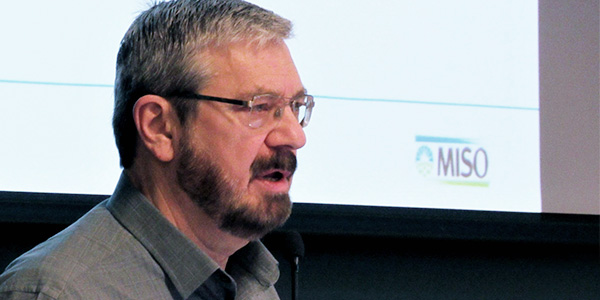By Amanda Durish Cook
MISO last week floated a relatively simple straw proposal for treating storage as a reliability asset in its annual transmission plan.
The proposal involves no interconnection queue entry, asset registration and day-ahead scheduling notices.
Speaking during a Sept. 26 Planning Advisory Committee meeting, Director of Planning Jeff Webb said the RTO hopes to get a final proposal in place in time for the 2019 MISO Transmission Expansion Plan cycle.
Webb said stakeholders have asked how storage projects providing reliability transmission services will be able to enter the MTEP.
“Well how does any other transmission project get in? It’s proposed as a solution in the planning process,” he said.
Webb explained the projects would be proposed in MTEP as either a baseline reliability project driven by NERC criteria and allocated to local pricing zones, or as an “other” reliability project not eligible for regional cost allocation. If the storage project solves the issue at the lowest cost, it will be included in the annual plan.
He stressed that MISO’s plan only serves to treat storage comparably to other transmission assets, clarifying that storage projects would not necessarily take priority over traditional wires projects because “storage has a lot of hurdles and costs” to overcome.
“There will be opportunities, I think, to use” storage, Webb added.
‘To Queue or not to Queue’
Webb said storage as transmission would not be required to enter the interconnection queue as long as the project will not participate in the energy and ancillary services markets. If a storage asset is planned for both reliability transmission services and market services, the asset must first respond to reliability needs in the transmission market. If MISO doesn’t need the asset for reliability transmission purposes, it would be free to participate in the energy market pursuant to MISO’s future Order 841 compliance plan, provided it has completed the interconnection queue.
The queue is required “if for no other reason than comparability with other resources that the project would be competing with in the energy market,” Webb said.
“There’s a lot of controversy; to queue or not to queue,” he said of stakeholder reactions. He also said opportunities for market participation by storage projects intended for transmission use will vary according to location, noting that, for example, storage located in rural Iowa with few generation options nearby will have different market opportunities than storage added in a large metropolitan area where generation is already abundant.
“So maybe the answer comes down to significance factors: Where and how big?” Webb mused.
Reliability storage projects will be required to complete asset registration to allow MISO to control the asset when it’s required to maintain system reliability. The asset will receive notice of need in the day-ahead schedule and be recalled as needed during the operations day. Like other transmission assets, the storage assets will be price-takers when under RTO instructions.
Webb said MISO hasn’t proposed rules to credit a storage asset’s market revenue against its transmission asset cost recovery. Some stakeholders have said that allowing the two revenue streams would incentivize dual-use storage to the point that transmission reliability is diminished.
Webb said he expects MISO and stakeholders to discuss storage as reliability transmission services through the first half of next year. He noted that MISO could possibly schedule a workshop on the topic in response to stakeholder requests.




